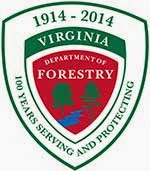The data for this survey was collected from 31,400 quarter-acre plots established at intervals of one-eight mile on compass lines 10 miles apart. The report contains summary statistics for the three physiographic regions of Virginia: Mountains, Piedmont and Costal Plain.
Since the blight had killed almost all standing chestnuts before 1940, the document reports only dead chestnuts. No significant volume was reported for the Coastal Plain but the dead chestnut volume reported for the mountains was 16% of the total volume, and 25% of the volume in trees greater than 20 inches in diameter. In the Piedmont the total dead chestnut volume was less than 5% but nearly 22% of the volume in trees greater than 20 inches in diameter.
The map below has a dot for every plot that contained at least 2 sound or cull chestnut trees 10-inches dbh or greater. Some real differences in certain counties are apparent and some are a bit surprising to me.


